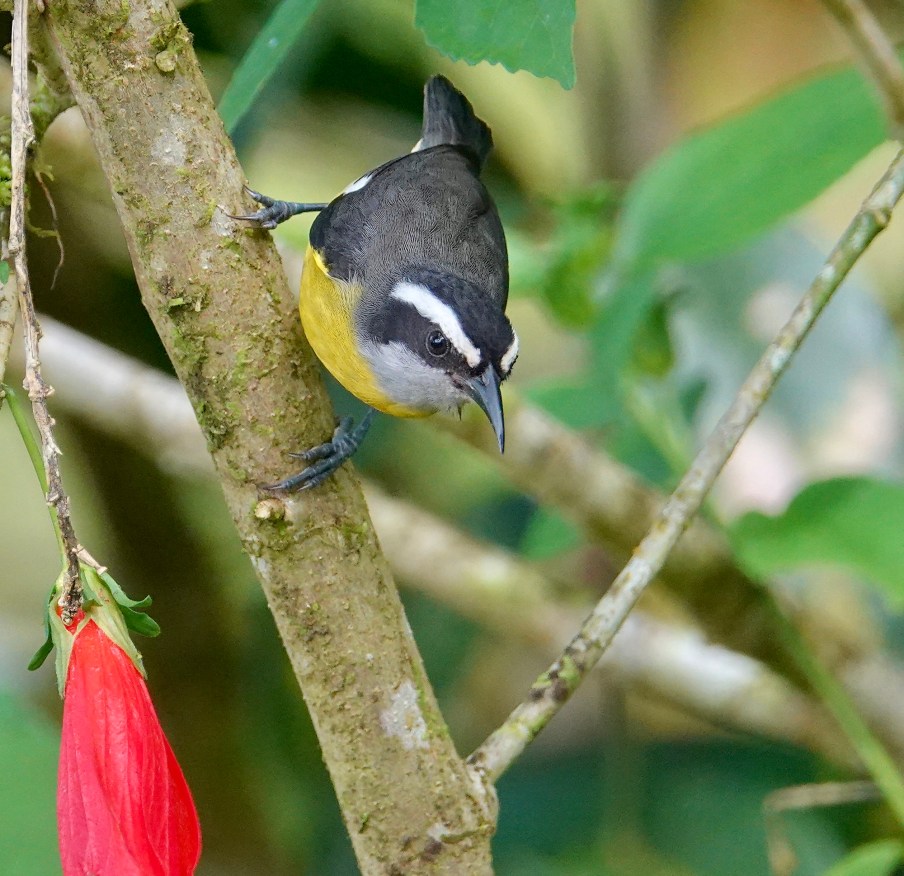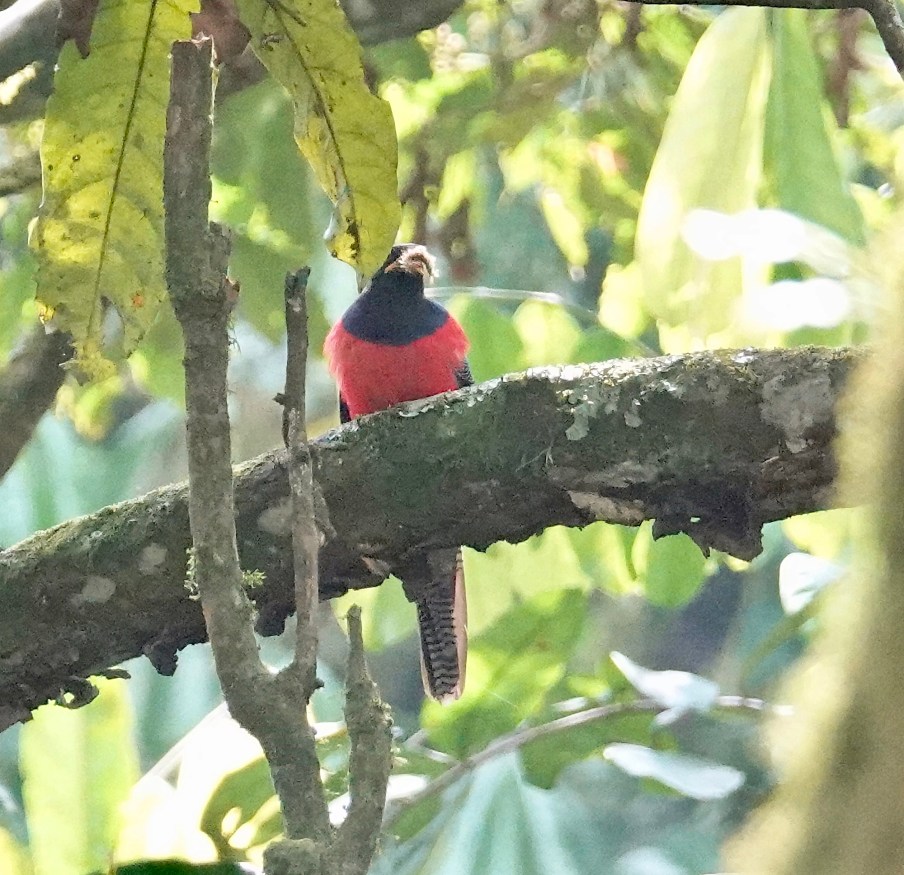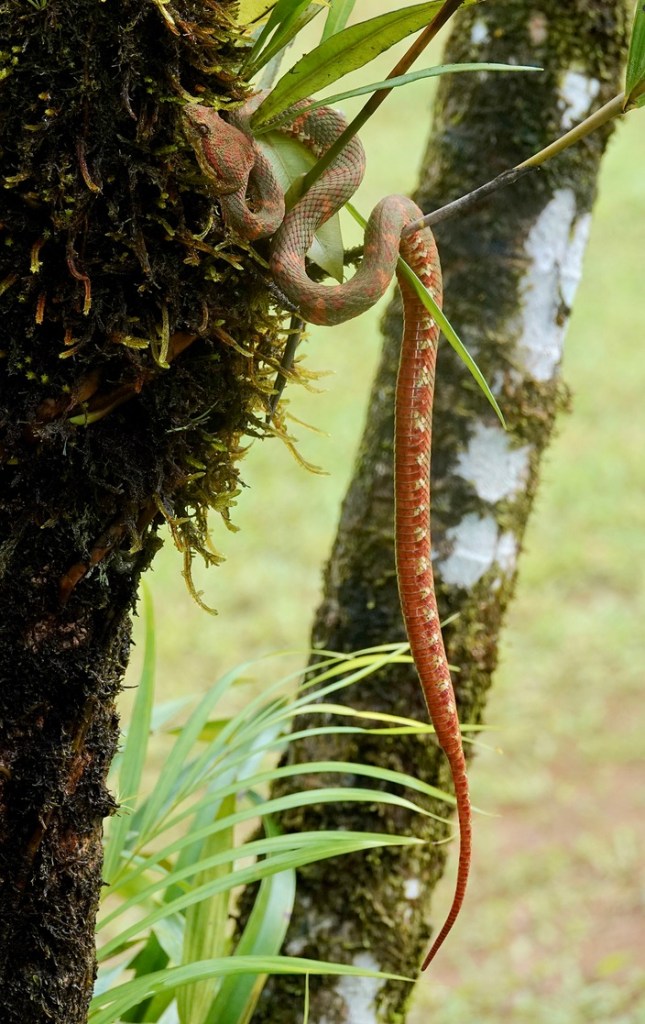Uganda Edition: Grey-throated Barbet

Grey-throated Barbet: Neck (Bwindi Impenetrable Forest National Park), Uganda, August 2022 — There are a lot of cryptic little birds in the forests of western Uganda, some found only there. This is the Grey-headed Barbet, not one of the rarer birds, with ranges in both far West and East Africa, and being common in the mountain forests of Western Uganda. It often likes to perch high in dead trees, which is exactly where we found this one. Sony Rx10iv at 600mm equivalent. Program mode with my custom birds and wildlife modifications. Processed in Pixelmator Photo and Apple Photos. ISO 125 @ f4 @ 1/500th.
Black-striped Woodcreeper

Black-striped Woodcreeper: Las Tardes Ecological Project, Corcovado National Park, Osa Peninsula, Costa Rica, December 2022 — In our guide, Mario’s opinion this is the most handsome of the woodcreepers of the Osa Peninsula and Costa Rica. It is not any easier to see than any of the others, sharing the habit of working up the trunks of trees in heady cover, but this one, part of a mixed flock we encountered after we had already turned back on our exploration of the road above Las Tardes, was more cooperative than most…giving us several good views. Sony Rx10iv at 600mm equivalent. Program mode with my custom birds and wildlife modifications, and multi-frame noise reduction. Processed in Pixelmator Photo on the iPad Pro. Equivalent ISO 3200 @ f4 @ 1/500th.
Uganda Edition: Speckled Tinkerbird and Yellow-spotted Barbet
Speckled Tinkerbird and Yellow-spotted Barbet, Neck (Bwindi Impenetrable Forest National Park), Uganda, August 2022 — Two Barbets in a single view…the Speckled Tinkerbird and the Yellow-spotted Barbet…both with all but identical ranges in the forests southwestern Uganda. These were at Neck on the way from Ishasha to Bwindi. Sony Rx10iv at 567mm equivalent. Program mode with my custom birds and wildlife modifications. Processed in Pixelmator Photo and Apple Photos. ISO 640 @ f4 @ 1/500th. Plus 1EV.
Golden-naped Woodpecker
Golden-naped Woodpecker: Las Tardes Community Ecology Project, Corcovado National Park, Osa Peninsula, Costa Rica, December 2022— This is from the road above the Las Tardes project. The Golden-naped Woodpecker is “near-endemic” of Costa Rica…only found in the south Pacific lowlands and foothills and just barely into Panama across the border. This is a female…the males have a small patch of red on the crown. Sony Rx10iv at 600mm equivalent. Program mode with my custom birds and wildlife modifications. Processed in Pixelmator Photo and Apple Photos. ISO 100 @ f4.5 @ 1/1000th.
Uganda Edition: Black-tailed Oriole (?)

Back-tailed Oriole (?): Neck, Bwindi Impenetrable Forest National Park, Uganda, August 2022 — Because of where we saw it, I believe this is a Black-tailed or Mountain Oriole. It is one of 4 very similar black-headed, yellow orioles possible in Uganda, but is the most likely in the Mountain Forest of Neck. Sony Rx10iv at 567mm equivalent. Program mode with my custom birds and wildlife modifications and multi-frame noise reduction. Processed in Pixelmator Photo and Apple Photos. Equivalent ISO 5000 @ f4 @ 1/500th. Plus 1.3EV.
Bright-rumpled Attila

Bright-rumpled Attila: Las Tardes Ecological Project, Corcovado National Park, Osa Peninsula, Costa Rica — My only excuse for this photo is that this very common bird of the Central American tropics is also very hard to see…the field guides say “more often herd than seen.” Not a great photograph, but it does show the bright rump that gives the bird its name, and the hooked beak that gives it its character! Sony Rx10iv at 600mm equivalent. Program mode with my custom birds and wildlife modifications. Processed in Pixelmator Pro and Apple Photos. (I had to dig the bird out of the shadows and it is a heavy crop.) ISO 100 @ f4 @ 1/500th.
Uganda Edition: Black Bee-eater

Black Bee-eater: Neck (Bwindi Impenetrable Forest National Park), Uganda, August 2022 — Another not great shot of a good bird. This is an immature (coming into adult plumage) Black Bee-eater from the Neck forest between Ishasha and Bwindi. Though it is a forest bird across most of Sub-Sahara Africa, it is found in East Africa only in the narrow band of volcanic highlands along the western border of Uganda. This bird as wee and far, as they say, so this is a heavy crop…and being silhouetted against the sky did not help. Sony Rx10iv at 600mm equivalent. Program mode with my custom birds and wildlife modifications. Processed in Pixelmator Pro on the Mac Air. ISO 100 @ f4 @ 1/500th. Plus 2.7EV.
Bananaquit

Bananaquit: Las Tardes Community Ecology Project, Corcovado National Park, Osa Peninsula, Costa Rica, December 2022 — The Bananaquit has long complicated story. It was placed with the new world warblers, or the sparrows (buntings), or maybe in a genus of its own…before genetic profiling put it with the tanagers, in the same sub-family as Darwin’s Finches. It is a wide-spread bird all through Central and South America and the Caribbean, occasionally reaching extreme South-Florida in the US. It has an unusual amount of variation over its range, with island birds in particular, being quite different looking than those found on the continents. It has 41 (41!) recognized sub-species, at least a few of which are already on track to be split into species of their own. So, no, not a simple bird, though common all through the American tropics. It eats nectar and fruit and can be seen around dwelling with gardens. It will come to bananas at feeders. Sony Rx10iv at 600mm equivalent. Program mode with my custom birds and wildlife modifications. Processed in Pixelmator Photo and Apple Photos. ISO 800 @ f4 @ 1/500th.
Uganda Edition: Bar-tailed Trogon

Bar-tailed Trogon: Neck, Bwindi Impenetrable Forest National Park, Uganda, August 2022 — Another good bird, though only a “for the record” shot, from our spot in forest of Neck along the road from Ishasha to Bwindi. The Bar-tailed Trogon is one of two trogons in East Africa and is only found in a narrow band just where we were in Uganda. This bird was distant, in the dark, and obscured by foliage, so I am, overall, happy with the record. 🙂 Sony Rx10iv at 600mm equivalent. Program mode with my custom birds and wildlife modifications. Processed in Pixelmator Pro on the Mac Air. ISO 2500 @ f4 @ 1/500. Plus 1.7EV.
Eyelash Pit Viper


Eyelash Pit Viper: Las Tardes Community Ecology Project, Corcovado National Park, Osa Penninsula, Costa Rica — As I mentioned in a previous post, because of high water and damaged roads up the river channel we could not take our normal tractor and trailer ride up the Recon River into Corcovado National Park, so we drove into the Las Tardes Community Ecology Project at the edge of the park. One of their projects is snake relocation. They pay local farmers to bring the snakes they encounter in their fields to them, rather than just killing them, and then, after keeping them a few days to make sure they are healthy, they relocate them deep in the park. On any given day they may have several venomous snakes ready for relocation. They brought out two Eyelash Pit Vipers for us to see and photograph: one the bright yellow we associate with the species, and this one which is quite different in color. It turns out that Eyelash Pit Vipers come in a variety of colors…and there can be any number of colors in a single hatch of eggs. Sony Rx10iv at 600 and 192mm equivalents. Program mode with my custom birds and wildlife modifications. Processed in Pixelmator Photo and Apple Photos. ISO 1600 and 400 @ f4 @ 1/500th and 1/400th.




